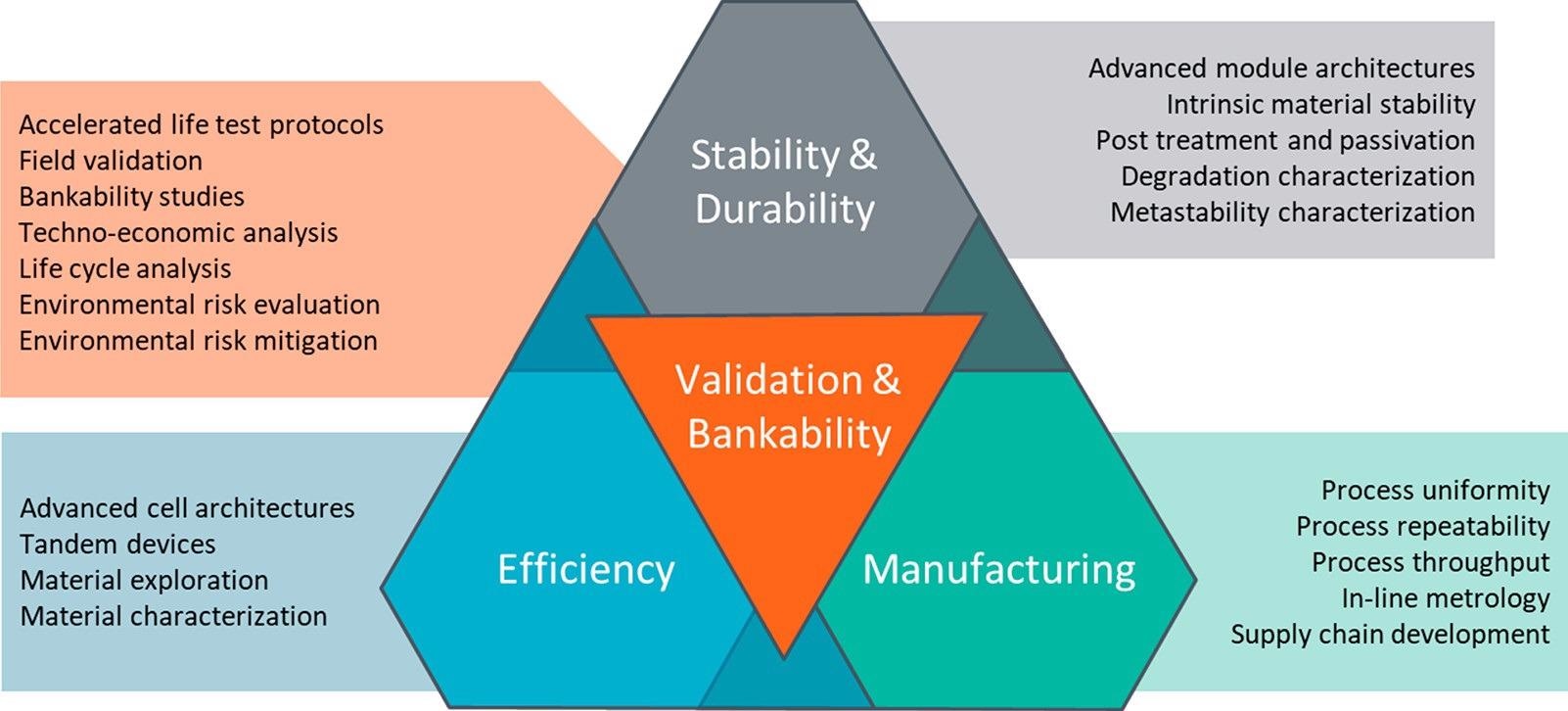 By Surbhi JainReviewed by Susha Cheriyedath, M.Sc.Apr 28 2022
By Surbhi JainReviewed by Susha Cheriyedath, M.Sc.Apr 28 2022In an article recently published in the journal ACS Energy Letters, researchers discussed the perspectives of the United States (US) Solar Energy Technologies Office (SETO) on the road to perovskite commercialization.

Study: The Path to Perovskite Commercialization: A Perspective from the United States Solar Energy Technologies Office. Image Credit: Clever Stock/Shutterstock.com
Background
Solar photovoltaic (PV) electricity is required in large quantities to meet the US government's decarbonization targets of zero economy-wide emissions of carbon by 2050 and 100% carbon-free generation of electricity by 2035. The US Department of Energy's SETO evaluated that year-by-year PV deployment levels would need to increase from 15 gigawatts alternating current (GWac) developed and installed in 2020 to 30 GWac by 2025, 60 GWac by 2030, and more than 100 GWac by 2035 to meet the country's 2035 emissions targets.
While incumbent technologies will continue to facilitate the majority of new installations required to get the US closer to these deployment targets, fledgling PV technologies may provide support to them as well.
Halide perovskites are a potential lab-scale PV technology. Before perovskite PV can reach commercial capability for power sector markets, however, considerable technical difficulties must be overcome. In the meanwhile, vigilance is required to avoid the fate of earlier thin-film PV technologies, which attracted significant capital investments before overcoming their techno-economic problems and could result in the loss of millions of dollars and investor skepticism about thin-film PV.
About the Study
In this study, the authors discussed SETO’s perspective on the commercialization of halide perovskite PV, which included the commercialization pitfalls, significant technical barriers, and possibilities, and how SETO could support efforts to overcome these challenges and barriers.
SETO-funded research was also mentioned to show how the funding decisions were in line with the overall goal. The primary technological challenges to perovskite PV commercialization, as categorized by SETO, were reviewed in three categories, i.e., module efficiency (scalability), durability and stability, and manufacturing, e.g., yield, process control, and so on.
The researchers demonstrated the role of durability as the most significant technological concern for perovskite PV. The survival prospects of perovskite PV in the field for at least 20 years were determined in order for levelized cost of electricity (LCOE) measurements to achieve SETO's 2030 goals of $0.02/kWh. The ability of perovskites to survive various environmental conditions was tested in order to achieve this lifetime.
The team determined ways to better understand and mitigate the chemical interactions of perovskite with oxygen and/or moisture. Many other degradation pathways were studied in addition to environmental durability.

Schematic of the technical challenges facing perovskite PV commercialization. Image Credit: Timothy D. Siegler et al., ACS Energy Letters
Observations
For optimum compositions, lab-scale perovskite PV devices with a surface area of smaller than 1 cm2 known as dot cells, attained verified device efficiencies of over 25%. Dot cells were shown to attain 20% efficiency across a wide variety of perovskite compositions, flexible substrates, and band gaps in the range from 1.24 eV to 1.7 eV. When combined into demonstration mini-modules with aperture areas of >500 cm2 and sizes bigger than 25 cm2, perovskite-only cell architectures reached 18% power conversion efficiency (PCE) for single-junction devices and 24% for all-perovskite tandems.
SETO's incubator program encouraged startups who were closer to pilot manufacturing and further along in the development cycle of the product to apply for funding. Since 2007, incubators had specialized in de-risking technologies based on their stage of development, whether through development and research initiatives or commercialization and demonstration. Traditional financing opportunity announcements (FOAs) in PV research and development (R&D) could help startups pursue work. SETO also provided highly competitive small innovative initiatives in solar (SIPS) awards for high-risk, one-year research projects.
Conclusions
In conclusion, this study elucidated that perovskite PV holds the potential to become a low-cost, high-efficiency module technology for use in the power sector, with energy payback durations and throughput rates that are superior to current PV technologies. A new PV technology could also assist in diversifying the supply chain, lowering the risk of meeting the ambitious PV deployment goals set by all countries at the climate change conference of the parties. Perovskite modules with low energy returns on investment could lead to even more solar PV deployment in the utility sector, as well as fairer access to a distributed generation of solar in the community solar and home solar sectors.
The authors mentioned that the successful implementation of perovskite PV technology is far from certain and emphasized that now is the time for fundamental and applied research in the perovskite community to better align their research goals with the wide technological needs and limitations of perovskite photovoltaics. In order to achieve this goal, SETO offers alternatives to aggressive/dilutive/high-risk sources of R&D funding, with a focus on relevant commercial targets and technological readiness, and technological development that meets timeline expectations appropriate for perovskite PV's current technological readiness level.
Disclaimer: The views expressed here are those of the author expressed in their private capacity and do not necessarily represent the views of AZoM.com Limited T/A AZoNetwork the owner and operator of this website. This disclaimer forms part of the Terms and conditions of use of this website.
Source:
Timothy D. Siegler et al. The Path to Perovskite Commercialization: A Perspective from the United States Solar Energy Technologies Office. ACS Energy Letters 7 1728-1734 (2022). https://pubs.acs.org/doi/10.1021/acsenergylett.2c00698